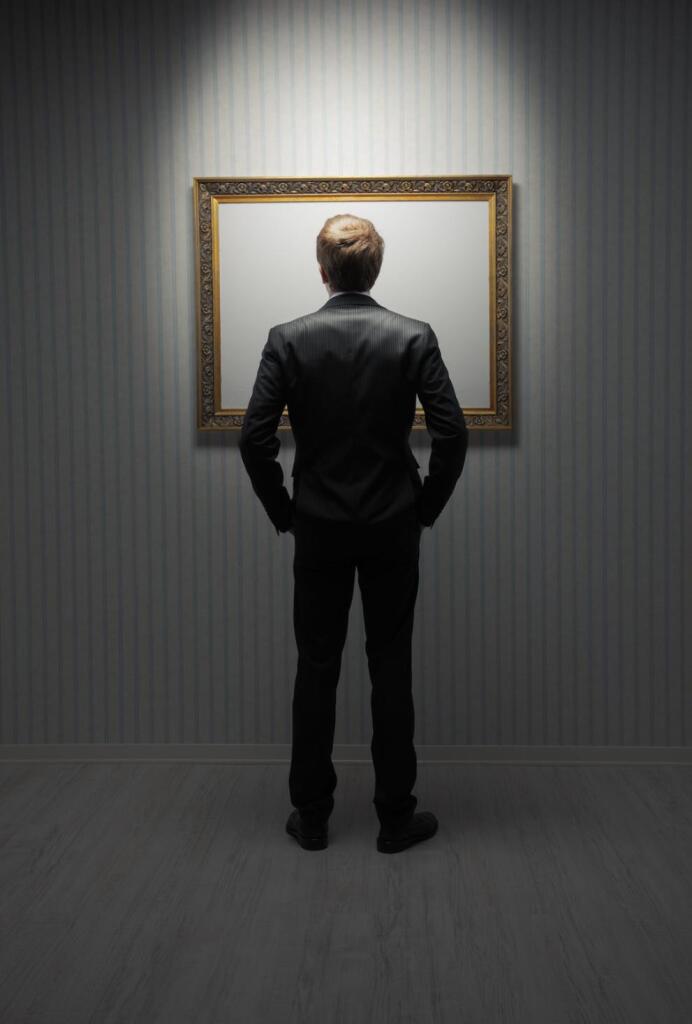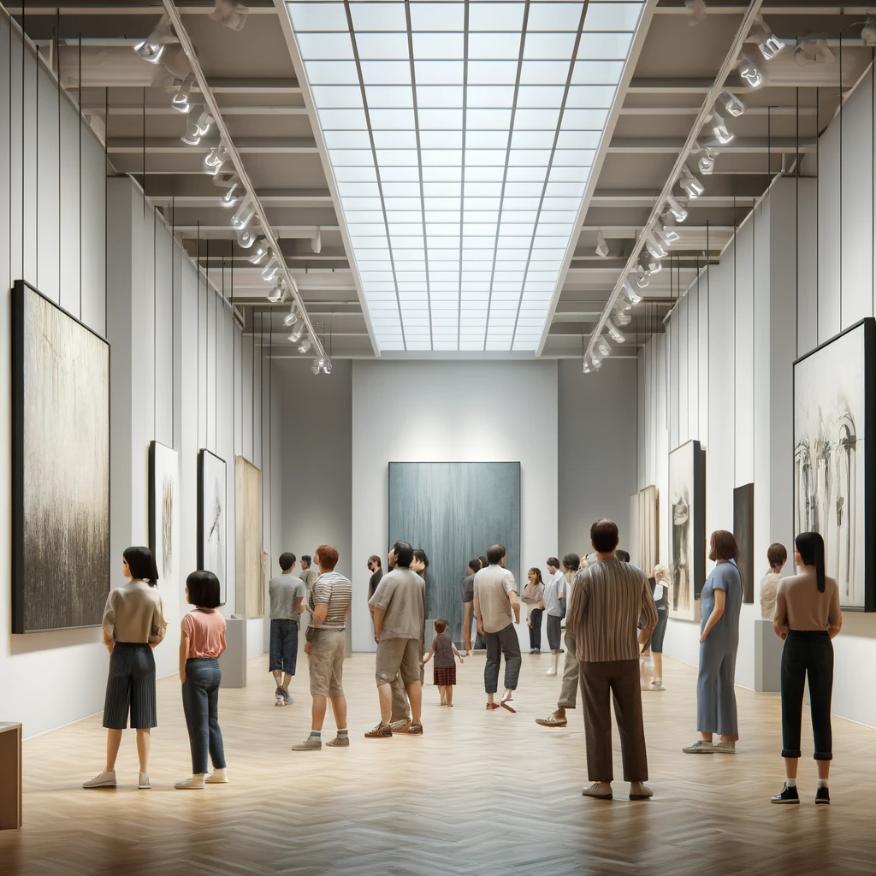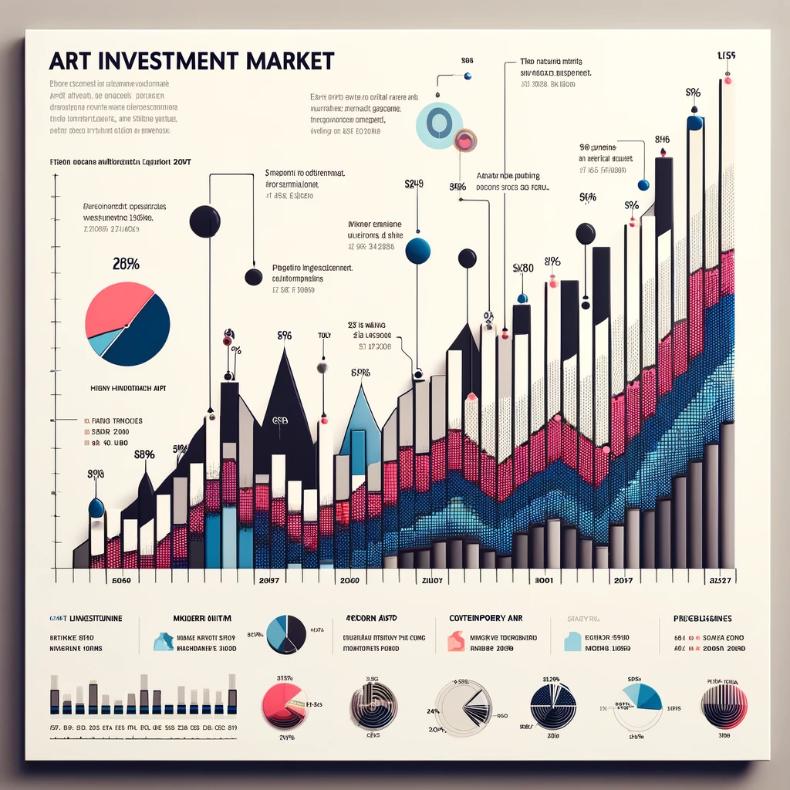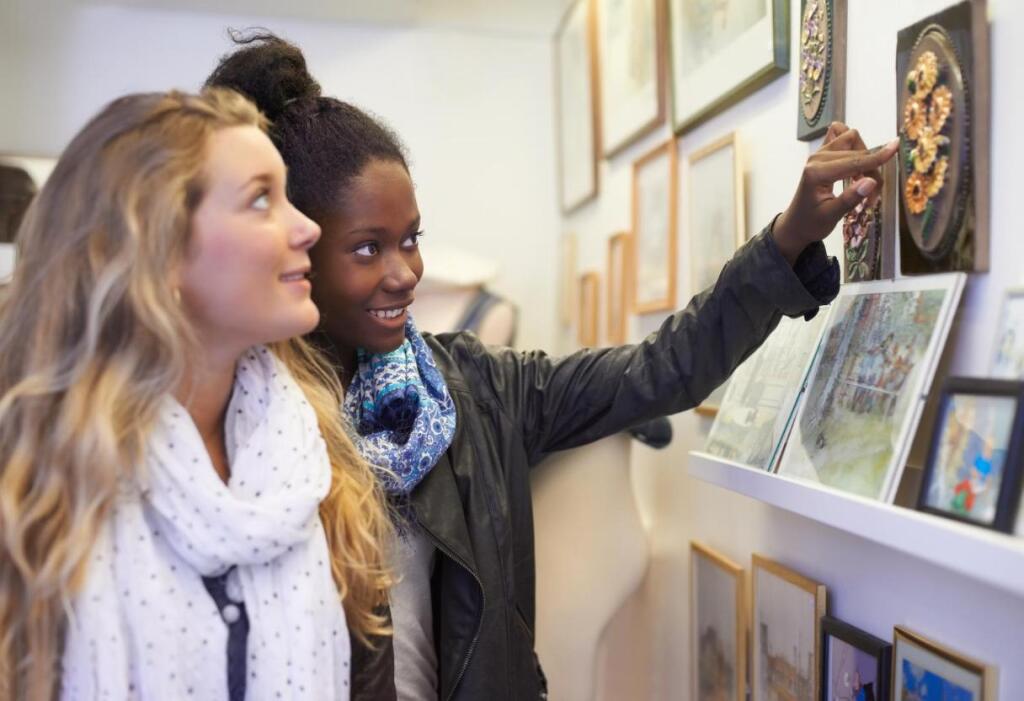- The Basics of Art Investment
- Acquisition Strategies
- Mastering the Art Market
- Using Technology for Art Investment Insights
- The Economics of Art Investing
- Art Investment Logistics
- Investment Vehicles in the Art World
- Art and its Correlation to the Wider Economy
- Art Investment for the Passionate Collector
- Mastering the Exit: Selling Your Art Investments
- Staying Informed: Art Investment Resources
- Art Investment Strategy: Tailoring to Your Portfolio
- Art Investment Advice: Learning from the Masters
- Future of Art Investment
- Wrapping Up: Key Takeaways for Aspiring Art Investors
- Frequently Asked Questions About Art Investment
- Further Reading

If you’ve got the knack for recognizing a beautiful piece of art and the guts for a bit of risk, shaping an art investment strategy for 2024 could be your ticket to diversifying that portfolio of yours. Let’s get one thing straight – throwing your hat into the ring of art collectors and investors isn’t a playground exclusive to the well-heeled anymore. If art stirs something in you, welcome aboard; the field is wide open.
Here’s the scoop: you’ve got options. Whether it’s snagging high-quality art reproductions or sinking your funds into steadfast blue-chip originals, the art market in 2024 is buzzing with avenues just waiting to be explored. And here’s the best part – you get to own something that not only has the potential to bulk up your asset column but also dazzles up your wall.
But, and this is a big but, venturing into the world of art investingArt Investment Strategy (Glossary Entry) An art investment strategy is a financial plan designed to guide purchases of art with the intention of earning returns on the capital invested, much like traditional asset classes. Unlike more liquid investments such as stocks or bonds, investing in art incorporates aesthetic appreciation with economic benefit, often incorporating elements of personal passion and market More is not without its mazes and pitfalls. Before you jump in, you need the lowdown on what it really takes to buy art that doesn’t just hang pretty but also packs a punch as an investment. So let’s roll up our sleeves and dive in – it’s time to sketch out a solid art investment strategy that stands up to the dynamic world of 2024.

The Basics of Art Investment
Dabbling in the art world as an investor requires a mix of passion and smarts. You’re not just buying a piece of art; you’re placing a bet on its future worth. Think of it as if you’re scouting for the next unicorn startup, but instead of tech whiz kids, your prospects are brush-wielding virtuosos or sculptors with the Midas touch.
Here, “appreciation” is key, and we are not just talking about the fuzzy feeling you get when you look at a painting of a sunset. It’s about the piece’s value climbing the financial ladder. And it’s about knowing when to hold ’em and when to fold ’em—timing in the art market is everything. Jump on a piece before the artist hits the big time, and you could be sitting on a goldmine.
But here’s the killer part: art investment is a marathon, not a sprint. Your chosen pieces might not shoot up in value overnight. It’s a play that could unfold over years, even decades. Patience is key.
Understanding Art Market Dynamics
Understanding the art market is like reading the winds before setting sail. The waters can be choppy, and sudden storms of economic downturns or shifts in cultural trends can toss your plans overboard if you’re not careful.
One crucial factor is the buzz around the artist. An unknown artist’s work could become the next hot ticket if they win a prestigious award or get featured in a high-profile exhibition. On the flip side, a seasoned artist’s passing could suddenly catapult their works to new heights of demand and value. Keeping a finger on the pulse of the art scene is part of the thrill.
The Art of Risk in Art Investments
Risk in art investment? Absolutely. But it’s not the kind that should have you breaking out in a cold sweat. Just like stocks, there’s volatility in art, but unlike stocks, you can’t track its value on a ticker tape. The art market can be subjective, fickle even. What’s adored today could be ignored tomorrow, and vice versa.
The key to managing risk is diversification. Don’t put all your coins in one jar. Spread your investments across different artists, styles, and periods. And always—always—invest in art that you love. That way, if the market doesn’t reward you, at least you’ll be rich in aesthetic pleasure.

Acquisition Strategies
When it comes to the specifics of purchasing art, the terrain is just as diverse as the artwork. Do you play it safe or go for the wild card? Do you begin small and aim high, or do you invest large right away? Let’s unwrap some strategies to see what fits your style.
Scouting for Potential: Emerging Artists vs. Established Names
Emerging artists are like the start-ups of the art world—full of potential and sometimes, just a break away from making it big. These are the creators whose narratives you can be a part of from the early chapters.
The advantage?
Their works come without the heavy-hitter price tag. But it’s not just about buying low with hopes of selling high; it’s about believing in the artist’s journey. Your support could help launch the next art world sensation.
Then there are the established names—the ones that already have a chapter in the art history books. Here, you’re looking at a steeper entry point, but these artists bring a legacy, and with it, a certain predictability in investment. Their markets are usually more stable, their futures, often less speculative.
Blue-Chip Artworks: A Safe Haven?
Speaking of stability, blue-chip artworks are the titans of the art investment world. These pieces, by artists who have stood the test of time, are the equivalents of your heavyweight stocks. They’re the Pablo Picassos, Gustav Klimts, and Jackson Pollocks—the names that even art novices recognize. Why? Because their value doesn’t just hang; it grows. Investing in a blue-chip is for those who look at art and see a legacy that will likely continue to appreciate.
Prints and Reproductions: Budget-Friendly Alternatives
Not everyone’s wallet is ready for the big leagues, and that’s where prints and reproductions step in. These pieces offer a slice of the art pie without the price tag that makes your bank account weep. Limited edition prints, especially those signed by the artist, can still offer a decent return on investment. They are a tangible entry point into the collector’s circle and can be a wise choice for someone crafting an art investment strategy that’s kinder to cash flow.
Acquiring art involves striking a balance between caution and passion, regardless of whether you are investing in a rising star or a dark horse. Your strategy could be a diverse portfolio that includes all three categories, buffering risk while still leaving room for pleasant surprises.

Mastering the Art Market
Mastering the art market is an art form in itself. It’s about more than just liking a painting; it’s about understanding the market currents that can turn a passion into profit. Whether you’re a tech-savvy collector or a traditionalist, here’s how you can navigate these waters with confidence.
Using Technology for Art Investment Insights
Technology is your new best friend in the art market. Tools like blockchain are ensuring authenticity and provenance, making ownership histories transparent. But let’s talk about how technology can get you ahead of the curve.
There’s a suite of apps and platforms at your fingertips offering real-time analytics and insights. Imagine having a database that alerts you to trending artists or artworks fetching unexpectedly high bids at auctions. These platforms can offer predictive insights, helping you make informed decisions.
Want to know the fair market value of a piece?
There’s an app for that. Curious about an artist’s exhibition history? A few clicks, and you have your answer. Technology is reshaping the art investment strategy, making it more accessible and data-driven.
Networking in Art Investment Circles
Let’s not forget the human element. Even in the digital age, art thrives on personal connections. Networking is crucial. Attend galleries, art fairs, and yes, even those posh art investment conferences. The art world is surprisingly small, and the more faces you recognize, the more insider knowledge you gain.
Chat up curators, mingle with artists, and get to know other collectors. They’re your eyes and ears on the ground. They can offer you tips on who’s about to take off or which artist’s market is cooling down. Building relationships can lead to private sales and first dibs on new works. Sometimes, the right conversation at an opening can lead to a deal that never hits the public market.
The Economics of Art Investing
When you’re looking to buy art with an investor’s eye, you’re signing up for a complex web of costs and potential gains. Here’s how to handle the financial side of art investingArt Investment Strategy (Glossary Entry) An art investment strategy is a financial plan designed to guide purchases of art with the intention of earning returns on the capital invested, much like traditional asset classes. Unlike more liquid investments such as stocks or bonds, investing in art incorporates aesthetic appreciation with economic benefit, often incorporating elements of personal passion and market More.
Calculating the Costs: From Purchase to Maintenance
Let’s talk numbers. Purchasing art requires consideration of all the factors involved, not just the price listed on the gallery wall. Auction fees, shipping, insurance—these can add an extra layer of expense to your initial purchase. And don’t forget about maintenance. Whether it’s a delicate watercolor that needs the right humidity or a sculpture that needs regular cleaning, keeping your art in mint condition is part of safeguarding your investment.
But it is not only about the outflow. If you’re savvy, you’ll look into tax benefits and incentives for collectors. In some places, investing in art can come with financial perks. Talk to a tax advisor who’s got a handle on art investments since they can give you the lowdown.
Predicting Artwork Appreciation
Here’s where your crystal ball needs to come out. Estimating which pieces of art will increase in value requires balancing educated guesses with intuition. Sure, you can look at historical data, market trends, even socio-political movements that might influence an artist’s relevance. But it’s not an exact science.
Staying on top of art market reports, getting to know what’s hot (and what’s not), and understanding the broader economic factors that affect art prices will be your tools. Remember, just like any investment, past performance isn’t always indicative of future results. What you can do is gather as much information as possible, look for patterns, and make your move with both confidence and caution.

Art Investment Logistics
The practical side of art investing—the logistics—is where the rubber meets the road. It’s about protecting and preserving the very tangible assets hanging on your wall or standing on your pedestal. The details might not be as glamorous as the gavel dropping on your winning auction bid, but they’re crucial to your art investment strategy.
Storage and Maintenance: Ensuring Art’s Value
First up is storage. Not every piece of art you own will be on display. For those masterpieces in waiting, you need the right conditions—temperature controlled, humidity checked, and secure. Whether you go for a professional storage facility or create a safe haven at home, remember this: poor storage can lead to deterioration, and with it, a plunge in value.
Maintenance is next. Dust might give a vintage feel, but let it settle, and you could be watching your investment deteriorate before your eyes. Regular cleaning, using the right materials and techniques, is a must. And then there’s the issue of restoration. Sometimes, to preserve value, you need to invest a bit more to bring an artwork back to its former glory, especially if it’s been through the wars.
The Ins and Outs of Art Insurance
Now, let’s talk protection—insurance. This isn’t your standard home contents policy. You’ll need a specialized art insurer, one who gets the nuances of art investment. They’ll consider everything from the artwork’s value to its provenance and current condition.
Insurance policies for art can cover a range of eventualities—damage, theft, even depreciation in some cases. And if you’re in the habit of loaning out pieces to galleries or museums, you’ll want to make sure they’re covered off-premises. A good insurer will walk you through the valuation process, help you understand the fine print, and make sure that if the worst happens, your investment isn’t wiped out.
In the world of art investment logistics, it’s about forward planning. Don’t let the behind-the-scenes details dampen the excitement of your art acquisition. Instead, see them as the safety net that lets your collection—and its value—soar.
Investment Vehicles in the Art World
The art investment landscape is rich with diverse vehicles, each offering a different route to enriching your portfolio. Traditional direct purchasing is just the beginning. Let’s look at two progressive options that are shaping the future of art investment: art funds and fractional ownership.
Diversifying with Art Funds
Art funds function much like mutual funds but are centered on accumulating and managing a collection of artworks. By investing in an art fund, you’re buying shares in a managed portfolio of curated art. These funds are typically overseen by experts who have a keen eye for artworks that not only have aesthetic appeal but also the potential for significant appreciation.
Art funds offer a way to spread risk across multiple pieces, and because they deal in artworks that might be out of reach for individual investors, they democratize access to higher-end markets. Plus, they handle the nitty-gritty details—authentication, acquisition, insurance, storage, and eventual sale—freeing you to enjoy the benefits without getting bogged down by the logistics.
Fractional Art Ownership: A Piece of the Masterpiece
Fractional art ownership is another innovative approach gaining traction. It is similar to fine art crowdsourcing. Through this model, you can own a share of a single artwork—be it a painting, sculpture, or even a digital work. This slices the cost of ownership significantly, putting otherwise unattainable works within reach.
Fractional ownership platforms also typically offer the sort of blockchain-backed provenance verification that savvy investors value. And while you might not get to hang the artwork on your wall, you do have the potential for a slice of the profits if it appreciates and is sold.
These investment vehicles add layers of flexibility and accessibility to the art world, allowing more people to take part in the financial rewards that art can provide. Whether you’re drawn to the diversified approach of an art fund or the shared ownership model of fractional investments, these vehicles are worth considering as part of a contemporary art investment strategy.
Art and its Correlation to the Wider Economy
Diving into art investment, you’ll quickly find that it’s not an isolated market. It moves to its own rhythm, sure, but it’s also influenced by the broader economic tides. Grasping this interplay is crucial for positioning your art investments wisely.
Comparing Art Investment to Traditional Stocks and Bonds
Art can be a maverick in your portfolio, often zigging when stocks zag. It’s known for its low correlation with traditional investments like stocks and bonds, which can be a double-edged sword. On one side, when the stock market dips, art can hold its ground or even gain value, providing a stabilizing effect on your overall portfolio. On the other, because it doesn’t follow stock market trends, its movements can be less predictable.
Art also tends to be a longer-term play. While stocks and bonds can be bought and sold in moments with the click of a button, art requires time—not only to sell but to appreciate in value. It’s about patience and timing. A downturn in the economy might see stock prices plummet, but quality art often endures these dips, even gaining value as investors look for tangible assets to weather the storm.
This isn’t to say you should pivot your entire portfolio to art. But as part of a diversified strategy, art can add a layer of insulation against market volatility. With all the technological advancements and shifts in global wealth, understanding where art fits alongside more traditional investments is more important than ever.
Art Investment for the Passionate Collector
Combining investment with passion takes you to a new level where the benefits go beyond the balance sheet. For the ardent collector, art investingArt Investment Strategy (Glossary Entry) An art investment strategy is a financial plan designed to guide purchases of art with the intention of earning returns on the capital invested, much like traditional asset classes. Unlike more liquid investments such as stocks or bonds, investing in art incorporates aesthetic appreciation with economic benefit, often incorporating elements of personal passion and market More becomes a personal dimension, enriching your life with beauty and expression that only art can provide.
The Intangible Joy of Owning Art
The true allure of collecting art lies in the indescribable fulfillment that comes from being surrounded by works that speak to you. It’s a connection that goes deeper than the potential financial return. Each piece you select tells a story, captures a moment, or represents a vision that resonates with your soul.
Owning art offers a sense of pride and satisfaction that’s unique to this form of investment. It’s an opportunity to support the arts, foster cultural heritage, and be part of a community that values creativity and expression.
This personal engagement with your collection can also inspire a more informed and heartfelt investment strategy. As a passionate collector, your instinct and emotional response to art can often lead to wise investment decisions, for they are grounded in a deep appreciation of the art’s intrinsic value, not just its price tag.
Mastering the Exit: Selling Your Art Investments
Selling art is a strategic move in the life cycle of an art investment. Knowing when to sell can be just as important as knowing what to buy.
When and How to Sell Your Art Investments
Unlike liquid assets, which can be sold almost instantly on a market, art sales can be a slow burn. You may need to wait for the right moment when market conditions and buyer interest align to get the best return on your investment.
How do you know when it’s time?
It could be when the artist’s market is peaking, or perhaps when you’ve noticed a sustained increase in demand for similar works. Sometimes external factors, like economic shifts or changes in consumer sentiment, signal the right time to divest.
Selling itself is an art form. Whether it’s through auction houses, private sales, or online platforms, each channel has its advantages. Auctions can create a sense of urgency and competition among buyers, potentially driving up the price. Private sales offer discretion and control over the selling process. Online sales platforms can reach a vast audience, but they also come with a lot of competition.
Remember, the goal isn’t just to sell, but to do so in a way that maximizes your return and aligns with your overall investment strategy. With the right timing and approach, exiting your art investment can be just as rewarding as the acquisition.
Staying Informed: Art Investment Resources
In the fast-evolving world of art investment, staying informed is essential. With the right resources at your disposal, you can make enlightened decisions that align with both market trends and your personal investment strategy.
Subscribing to Trusted Art Investment News and Analysis
Subscribing to reputable art investment news and analysis platforms can provide you with an invaluable edge. These resources deliver up-to-date information on market trends, upcoming auctions, notable sales, and shifts in the art economy that could impact your investments.
Whether it’s daily newsletters, expert blogs, or industry reports, having access to current data helps you stay ahead of the curve. These insights allow you to anticipate market movements, understand pricing dynamics, and even discover emerging artists with potential for significant appreciation.
The Role of Art Investment Analysts
Art investment analysts play a pivotal role in shaping investment strategies. These professionals analyze market data, study historical sales, and assess economic indicators to forecast trends and potential investment opportunities. Their expertise can be particularly valuable when assessing the risk associated with certain purchases or predicting the future value of artworks.
Engaging with an analyst can provide you with tailored advice that considers both the broader market and your specific goals. They can help you navigate the complexities of the art market, from evaluating the authenticity and provenance of pieces to understanding the impact of global economic conditions on art prices.

Art Investment Strategy: Tailoring to Your Portfolio
Creating a sophisticated art investment plan that works in harmony with your larger financial portfolio is essential to maximizing profits and lowering risks. It’s about finding the right mix of passion and prudence.
Balancing Passion with Prudence
When you first start investing in art, it is common to be emotionally drawn in by a striking piece. However, a successful investor knows that combining an emotional connection with strategic foresight is key. Here’s how you can balance your passion for art with the prudence of an investor:
- Define Your Financial Goals: Start by understanding what you want to achieve through your art investments. Are you looking for long-term appreciation, or do you seek quicker returns through active trading? Knowing your financial objectives will guide your buying decisions.
- Assess Your Risk Tolerance: Art markets can be volatile, with values fluctuating based on trends, economic conditions, and artist recognition. Assess how much risk you are willing to take on. If you prefer a safer route, consider well-established artists or blue-chip art. If you’re open to risk, emerging artists might offer significant upside.
- Diversify Your Art Holdings: Just as with stocks and bonds, diversification in your art collection can help mitigate risks. Include a mix of styles, periods, and artists. This strategy not only enriches your collection aesthetically but also spreads the financial risk across different market segments.
- Stay Informed: Keeping abreast of market trends, artist developments, and historical data will enhance your ability to make informed decisions. Utilize resources like art advisors, investment analysis, and market reports to stay knowledgeable.
- Plan for Liquidity: Art is a notoriously illiquid investment, so plan your cash flow accordingly. Understand the time it might take to sell an artwork and plan your financial needs without relying on quick sales of your art pieces.
- Enjoy the Art: While it’s important to focus on the financial aspects, don’t lose sight of the joy that art brings. Investing in pieces you love means that no matter the market conditions, you derive satisfaction and value from your investment.
By incorporating these strategies into your approach, you can enjoy the dual rewards of personal enjoyment and financial gain, making your art collection both a source of pride and a prudent investment.
Art Investment Advice: Learning from the Masters
Drawing insights from seasoned art investors can dramatically shape your approach and success in the art market. They have been through the highs and lows of investing, and their experiences serve as valuable lessons for new and seasoned collectors.
Insights from Seasoned Art Investors
Seasoned investors have seen market fluctuations, artist evolutions, and economic shifts, all of which influence how art appreciates in value. Here are key insights you can glean from these masters of the art investment world:
- Research is Key: Long-time investors emphasize the importance of thorough research. Understanding an artist’s background, the provenance of artwork, and the current market trends are crucial. They often suggest going beyond popular names and exploring niche markets or emerging artists where there may be opportunities for significant growth.
- Network Extensively: Building relationships in the art world is invaluable. Seasoned investors often highlight their connections with galleries, curators, and other collectors, which have opened up opportunities and provided insider knowledge. Attending openings, art fairs, and auctions not only helps in making these connections but also in understanding current market sentiments.
- Buy What You Love, But Be Strategic: A common piece of advice from experienced art investors is to buy art that you love, as this ensures personal satisfaction regardless of the market’s performance. However, they also caution to remain strategic—consider how each piece fits into your broader investment strategy and portfolio.
- Understand the Importance of Timing: Knowing when to buy and sell is as much an art as it is a science. Masters of art investment often talk about the timing of their acquisitions and sales as factors critical to their success. They keep an eye on market trends, artist milestones, and global economic factors that might influence the art market.
- Leverage Expertise: Even the most experienced investors rely on a network of advisors, including art historians, investment analysts, and legal experts. This multidisciplinary approach helps them to make well-informed decisions that are legally sound and financially prudent.
- Prepare for the Long Haul: Art investment is not typically a quick flip. Successful collectors often approach art as a long-term investment, which might only see significant returns over many years. Patience is often cited as a virtue that has led to substantial rewards.
By adopting these strategies and insights from seasoned art investors, you can enhance your understanding of the art market and improve your ability to make savvy investment choices.

Future of Art Investment
It’s clear that the landscape of art investingArt Investment Strategy (Glossary Entry) An art investment strategy is a financial plan designed to guide purchases of art with the intention of earning returns on the capital invested, much like traditional asset classes. Unlike more liquid investments such as stocks or bonds, investing in art incorporates aesthetic appreciation with economic benefit, often incorporating elements of personal passion and market More is rapidly evolving. Changing collector demographics and technological advancements are defining new trends and creating new investment opportunities. What lies ahead? Let’s find out.
The Emergence of Digital Art and NFTs in the Investment Sphere
Digital artDigital art refers to a range of artistic works and practices that use digital technology as an essential part of the creative or presentation process. Since the 1970s, various names have been used to describe the process, including computer art and multimedia art. Digital art is itself placed under the larger umbrella term of new media art. The digital art More and Non-Fungible Tokens (NFTs) have burst onto the scene, revolutionizing how we perceive and invest in art. These digital assets, which range from digital paintings and sculptures to multimedia experiences, offer unique ownership rights made possible through blockchain technology. NFTs in particular have captured the imagination of the tech-savvy generation and investors looking for novel assets.
This shift towards digital formats poses an exciting frontier for art collectors. The digital sphere breaks traditional barriers to entry, allowing more artists to showcase their work and a broader audience to invest. For investors, this means access to a global market and the potential for high liquidity. However, as with any emerging market, there are risks involved, especially around the volatility and the nascent regulatory landscape.
Art Investment Trends to Watch
Beyond digital artDigital art refers to a range of artistic works and practices that use digital technology as an essential part of the creative or presentation process. Since the 1970s, various names have been used to describe the process, including computer art and multimedia art. Digital art is itself placed under the larger umbrella term of new media art. The digital art More, several trends are shaping the future of art investment:
- Sustainability in Art: More collectors and investors are considering the environmental impact of their art purchases, leading to increased interest in sustainable art practices and materials.
- Global Market Expansion: The art market is becoming increasingly global with significant growth in Asia and the Middle East. This expansion is diversifying investment opportunities and introducing new cultural contexts.
- Art as Part of Alternative Investment Portfolios: With the increasing unpredictability of traditional markets, more investors are looking at art as a part of alternative investment strategies, which can provide diversification and resilience against economic downturns.
Understanding these trends and staying ahead of them can help you adapt your investment strategy to capture new opportunities and navigate potential challenges. The future of art investment is dynamic and promises new forms of value both economically and culturally.
Wrapping Up: Key Takeaways for Aspiring Art Investors
Art investingArt Investment Strategy (Glossary Entry) An art investment strategy is a financial plan designed to guide purchases of art with the intention of earning returns on the capital invested, much like traditional asset classes. Unlike more liquid investments such as stocks or bonds, investing in art incorporates aesthetic appreciation with economic benefit, often incorporating elements of personal passion and market More not only offers the joy of owning beautiful objects but also the potential for significant financial returns. Here are the key takeaways to keep in mind as you start on or continue your endeavor in art investment:
- Educate Yourself: Understanding the nuances of the art market is crucial. Continuously educate yourself about market trends, historical data, and the cultural significance of different art forms. Knowledge is power in the dynamic world of art.
- Start with Passion, Proceed with Caution: Invest in art that resonates with you personally, but also ensure that each purchase fits into a broader investment strategy. Balancing your personal taste with strategic financial planning will lead to more satisfying and potentially lucrative outcomes.
- Diversify Your Portfolio: Just as with other types of investments, diversification within your art collection can mitigate risk. Include a mix of emerging artists and established names, different art styles, and various forms of media.
- Utilize Technology: Leverage digital tools and platforms that provide insights into the art market. From blockchain for verifying authenticity to platforms that track art market trends, technology is an invaluable ally.
- Build Networks: Relationships are key in the art world. Network with artists, galleries, and other collectors. These connections can provide you with valuable insights and opportunities that are not available to the general public.
- Plan for Long-Term Investment: Art is typically a long-term investment. Be patient with your investments, as it often takes time for art pieces to appreciate in value.
- Stay Adaptable: The art market can change rapidly. New trends, such as the rise of digital artDigital art refers to a range of artistic works and practices that use digital technology as an essential part of the creative or presentation process. Since the 1970s, various names have been used to describe the process, including computer art and multimedia art. Digital art is itself placed under the larger umbrella term of new media art. The digital art More and NFTs, can transform the market. Stay adaptable and open to exploring new avenues within art investment.
With these tips and a healthy dose of caution mixed in, you can optimize both your personal enjoyment and the financial returns on your art investment. Let’s explore what it means to be an art investor—a rich mix of learning, appreciation, and smart investing where beauty meets business.

Frequently Asked Questions About Art Investment
Q: What are the first steps for investing in art?
A: To begin investing in art, first educate yourself about the market and different types of art. Consider attending an art investment conference or visiting an art investment gallery to gain firsthand insight and advice. These actions will help you develop a foundational art investment strategy that aligns with your financial and aesthetic goals.
Q: How can art investment galleries enhance my art investingArt Investment Strategy (Glossary Entry) An art investment strategy is a financial plan designed to guide purchases of art with the intention of earning returns on the capital invested, much like traditional asset classes. Unlike more liquid investments such as stocks or bonds, investing in art incorporates aesthetic appreciation with economic benefit, often incorporating elements of personal passion and market More experience?
A: Art investment galleries play a crucial role by showcasing works from both emerging and established artists, providing you with a range of investment options. They offer expert art investment advice and can guide you on how to assess the potential art investment performance. Additionally, these galleries often host events and previews that can help you network with other investors and professionals in the field.
Q: What should I consider when developing an art investment strategy?
A: When crafting your art investment strategy, consider the market’s volatility, your personal risk tolerance, and the liquidity of art assets. It’s advisable to consult with an art investment analyst to understand current art investment news and trends. This strategy should align with your overall portfolio goals and include a mix of different art forms and styles for diversification.
Q: How do NFTs fit into modern art investingArt Investment Strategy (Glossary Entry) An art investment strategy is a financial plan designed to guide purchases of art with the intention of earning returns on the capital invested, much like traditional asset classes. Unlike more liquid investments such as stocks or bonds, investing in art incorporates aesthetic appreciation with economic benefit, often incorporating elements of personal passion and market More?
A: NFTs have revolutionized art investingArt Investment Strategy (Glossary Entry) An art investment strategy is a financial plan designed to guide purchases of art with the intention of earning returns on the capital invested, much like traditional asset classes. Unlike more liquid investments such as stocks or bonds, investing in art incorporates aesthetic appreciation with economic benefit, often incorporating elements of personal passion and market More by digitizing ownership and provenance of unique artworks on blockchain technology. This integration allows for broader accessibility and liquidity in the art market. For those looking into how to invest in art digitally, NFTs offer a contemporary approach that can coexist with traditional fine art investingArt Investment Strategy (Glossary Entry) An art investment strategy is a financial plan designed to guide purchases of art with the intention of earning returns on the capital invested, much like traditional asset classes. Unlike more liquid investments such as stocks or bonds, investing in art incorporates aesthetic appreciation with economic benefit, often incorporating elements of personal passion and market More practices.
Q: What are the functions of art galleries in terms of investments?
A: The functions of art galleries in investments include curating and showcasing artworks that have potential for appreciation, providing a platform for buyers and sellers, and offering expert guidance on art investment strategy. They also facilitate networking opportunities that can lead to partnerships and collaborations within the art community. Essentially, galleries help to bridge the gap between artists and investors, fostering a dynamic investment environment.
Q: What are some reliable sources for art investment news?
A: Reliable sources for art investment news include established art market magazines, specialized online platforms, and newsletters from leading art analytics firms. These sources provide updates on market trends, upcoming auctions, and key shifts in the art investment landscape. Staying informed through these channels is crucial for making educated investment decisions and tracking the art investment performance of your portfolio.
Q: How do I assess fine art investment returns?
A: To assess fine art investment returns, consider the historical price appreciation of similar artworks, consult market analysis reports, and track sales data from auctions and galleries. It’s also beneficial to work with an art investment analyst who can provide insights specific to your collection. These measures will help you understand the financial growth of your investments and strategize future acquisitions.
Q: What advice would you give to someone new to art investingArt Investment Strategy (Glossary Entry) An art investment strategy is a financial plan designed to guide purchases of art with the intention of earning returns on the capital invested, much like traditional asset classes. Unlike more liquid investments such as stocks or bonds, investing in art incorporates aesthetic appreciation with economic benefit, often incorporating elements of personal passion and market More?
A: For those new to art investingArt Investment Strategy (Glossary Entry) An art investment strategy is a financial plan designed to guide purchases of art with the intention of earning returns on the capital invested, much like traditional asset classes. Unlike more liquid investments such as stocks or bonds, investing in art incorporates aesthetic appreciation with economic benefit, often incorporating elements of personal passion and market More, start by visiting local exhibitions and art investment galleries to familiarize yourself with different styles and artists. Engage with seasoned collectors for art investment advice and consider starting with less expensive pieces to mitigate initial risk. Finally, continually educate yourself about market dynamics through art investment news and publications to build a robust art investment strategy.
Further Reading
To gain a deeper understanding of art investments, here are some valuable perspectives that delve into different aspects of the market and its dynamics.
- Stanford Graduate School of Business discusses the risks and returns of art investment, revealing that artworks, while often bought for potential financial gain, show a lower-than-expected performance compared to traditional investments like stocks and bonds. The study highlights the unique market behaviors and the importance of selection bias in art investments, where only the best-performing pieces tend to be resold, potentially skewing perception of overall market performance.
- Knight Frank provides insights into the practical aspects of art as an alternative investment, including the growth of art investment as a way to diversify investment portfolios. Their analysis underscores the fluctuating but potentially lucrative nature of the art market, offering a real-world example of significant returns from strategic purchases and sales.
- Artelier.com examines the primary and secondary art markets, explaining the dynamics between the two and how they affect art prices. This source is valuable for understanding how artworks gain value over time and the roles galleries and direct artist interactions play in the investment process.
- Artsy sheds light on current trends in the art market, particularly the impressive performance of high-value artworks despite overall market downtrends. It also discusses the emerging practice of art-secured lending, which allows collectors to borrow against their artworks without selling them, highlighting the liquidity challenges and opportunities in the art investment landscape (Read more here).
These sources provide a comprehensive overview of art investment from academic and practical viewpoints, offering valuable knowledge for anyone looking to deepen their understanding or actively engage in the art market.
You might enjoy also reading the following articles by Pigment Pool:
Modern and Contemporary Art – What is the Difference?
25 Facts to Know About Egon Schiele: Klimt, Women, and Austrian Expressionism
Art, Psychology, and Neuroaesthetics: Appreciate Art for Health and Well-Being
Celebrated, wronged, or neglected: 21 female painters of modernism that shaped the art world
Pop Art Ideas: Easy Painting Techniques to Capture the Warhol Essence
Mandala and Meaning: The History and Significance of Mandalas
